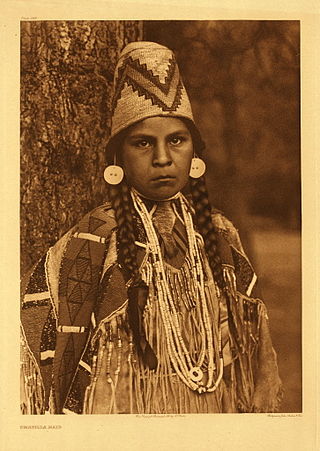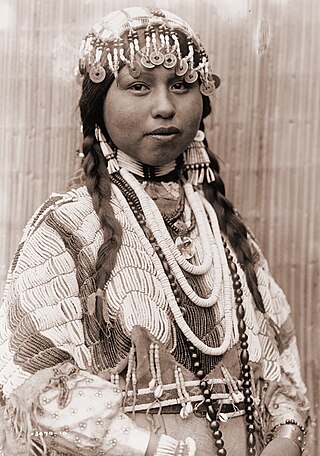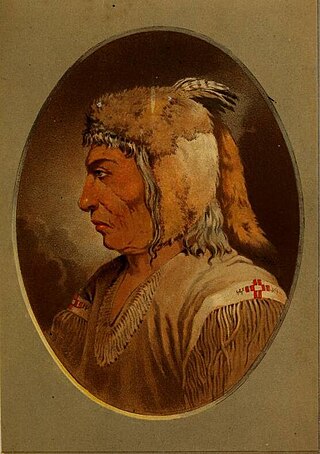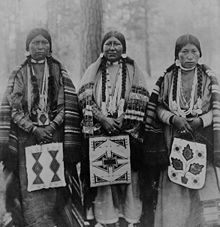
The Yakama are a Native American tribe with nearly 10,851 members, based primarily in eastern Washington state.

Chinookan peoples include several groups of Indigenous people of the Pacific Northwest in the United States who speak the Chinookan languages. Since at least 4000 BCE Chinookan peoples have resided along the Lower and Middle Columbia River (Wimahl) from the river's gorge downstream (west) to the river's mouth, and along adjacent portions of the coasts, from Tillamook Head of present-day Oregon in the south, north to Willapa Bay in southwest Washington. In 1805 the Lewis and Clark Expedition encountered the Chinook Tribe on the lower Columbia.

The Warm Springs Indian Reservation consists of 1,019 square miles (2,640 km2) in north-central Oregon, in the United States, and is governed by the Confederated Tribes of Warm Springs.

The Umatilla are a Sahaptin-speaking Native American tribe who traditionally inhabited the Columbia Plateau region of the northwestern United States, along the Umatilla and Columbia rivers.

The Confederated Tribes of the Umatilla Indian Reservation are the federally recognized confederations of three Sahaptin-speaking Native American tribes who traditionally inhabited the Columbia River Plateau region: the Cayuse, Umatilla, and Walla Walla.

The Confederated Tribes of the Grand Ronde Community of Oregon (CTGR) is a federally recognized tribe of Indigenous peoples of the Northwest Plateau. They consist of 27 Native American tribes with long historical ties to present-day western Oregon between the western boundary of the Oregon Coast and the eastern boundary of the Cascade Range, and the northern boundary of southwestern Washington and the southern boundary of northern California.
Kathlamet was a Chinookan language that was spoken around the border of Washington and Oregon by the Kathlamet people. The most extensive records of the language were made by Franz Boas, and a grammar was documented in the dissertation of Dell Hymes. It became extinct in the 1930s and there is little text left of it.
Sahaptin or Shahaptin, endonym Ichishkin, is one of the two-language Sahaptian branch of the Plateau Penutian family spoken in a section of the northwestern plateau along the Columbia River and its tributaries in southern Washington, northern Oregon, and southwestern Idaho, in the United States; the other language is Nez Perce or Niimi'ipuutímt.

Northern Paiute, endonym Numu, also known as Paviotso, is a Western Numic language of the Uto-Aztecan family, which according to Marianne Mithun had around 500 fluent speakers in 1994. It is closely related to the Mono language.

Wasco-Wishram are two closely related Chinook Indian tribes from the Columbia River in Oregon. Today the tribes are part of the Confederated Tribes of Warm Springs living in the Warm Springs Indian Reservation in Oregon and Confederated Tribes and Bands of the Yakama Nation living in the Yakama Indian Reservation in Washington.
Upper Chinook, endonym Kiksht, also known as Columbia Chinook, and Wasco-Wishram after its last surviving dialect, is a recently extinct language of the US Pacific Northwest. It had 69 speakers in 1990, of whom 7 were monolingual: five Wasco and two Wishram. In 2001, there were five remaining speakers of Wasco.
Umatilla is a variety of Southern Sahaptin, part of the Sahaptian subfamily of the Plateau Penutian group. It was spoken during late aboriginal times along the Columbia River and is therefore also called Columbia River Sahaptin. It is currently spoken as a first language by a few dozen elders and some adults in the Umatilla Reservation in Oregon. Some sources say that Umatilla is derived from imatilám-hlama: hlama means 'those living at' or 'people of' and there is an ongoing debate about the meaning of imatilám, but it is said to be an island in the Columbia River. B. Rigsby and N. Rude mention the village of ímatalam that was situated at the mouth of the Umatilla River and where the language was spoken.

The Tenino people, commonly known today as the Warm Springs bands, are several Sahaptin Native American subtribes which historically occupied territory located in the North-Central portion of the American state of Oregon. The Tenino people included four localized subtribes — the Tygh or "Upper Deschutes" divided in Tayxɫáma, Tiɫxniɫáma and Mliɫáma, the Wyam (Wayámɫáma) (Wayámpam) or "Lower Deschutes", also known as "Celilo Indians", the Dalles Tenino or "Tinainu (Tinaynuɫáma)", also known as "Tenino proper"; and the Dock-Spus (Tukspush) (Takspasɫáma) or "John Day."

The Burns Paiute Tribe of the Burns Paiute Indian Colony of Oregon is a federally recognized tribe of Northern Paiute Indians in Harney County, Oregon, United States.
Billy Chinook was a chief and member of the Wasco tribe. Chinook was a guide for John C. Frémont and Kit Carson, who explored Central Oregon from 1843 to 1844 and from 1845 to 1847. Chinook also served as First Sergeant, U.S. Army Wasco Scouts during the Snake War. Lake Billy Chinook in Oregon is named in his honor.

Sherar's Falls, is a small waterfall along the Deschutes River shortly before emptying into the Columbia River. It is a place considered a sacred fishing ground by local native tribes. It is located just north of the city of Maupin on Oregon Route 216 at Sherar's Bridge in Wasco County, in the U.S. state of Oregon. It totals 15 feet fall in a single drop and is the last waterfall along the Deschutes River before the Columbia River. The waterfall is rated as a class 6 whitewater and has an administrative closure to boaters because of the danger. It was named after Joseph Sherar, a 19th-century wagon road builder.

Joseph Sherar was a 19th-century wagon road builder who, with his wife, Jane, owned and operated a Deschutes River toll bridge and a nearby stagecoach station and hotel in Wasco County in the U.S. state of Oregon. The bridge and buildings were slightly downstream of Sherars Falls, the river's lowermost waterfall, and a traditional fishing spot for the native inhabitants of the region.

Emily Waheneka (1919-2008) was a Native American artist, of Warm Springs, Wasco and Paiute tribal heritage.

The Skinpah were a Sahaptin-speaking people of the Tenino dialect living along the northern bank of the Columbia River in what is now south-central Washington. They were first recorded as the E-nee-shers in 1805 by Lewis and Clark. Their village, Sk'in, was located adjacent to Celilo Falls in modern day Klickitat County.














